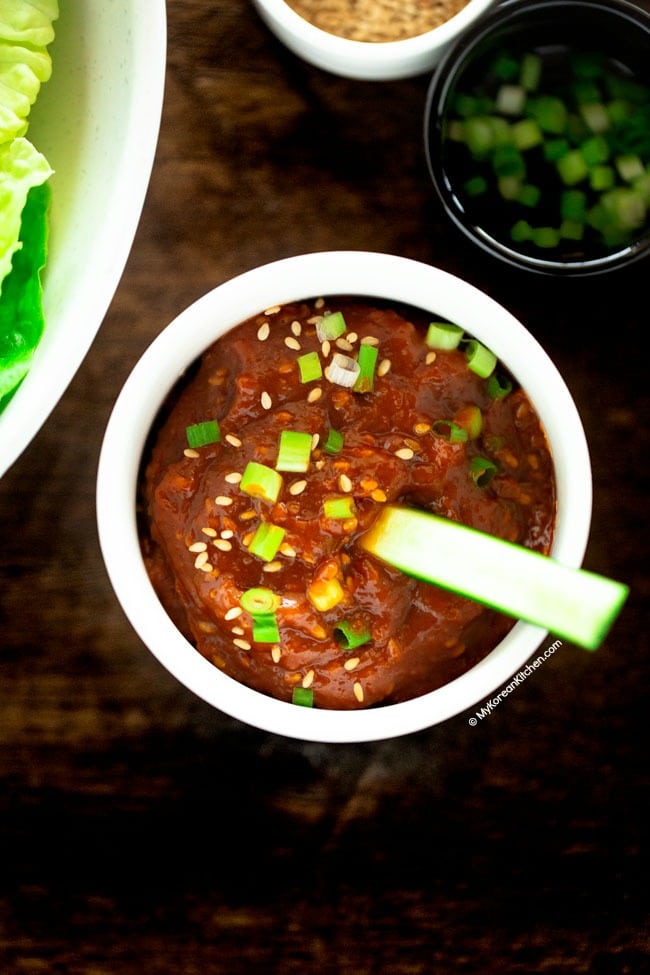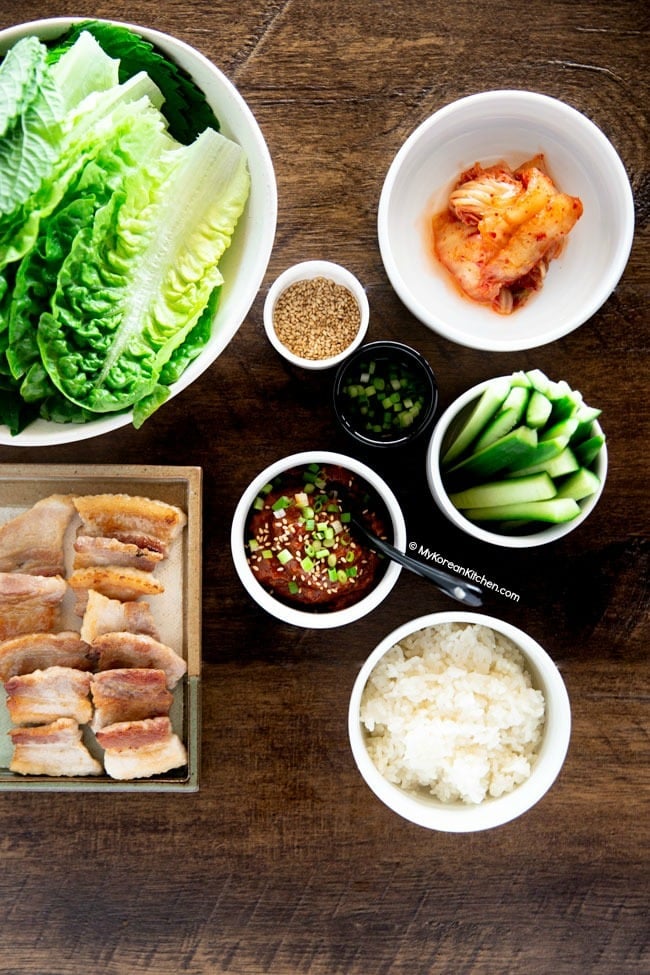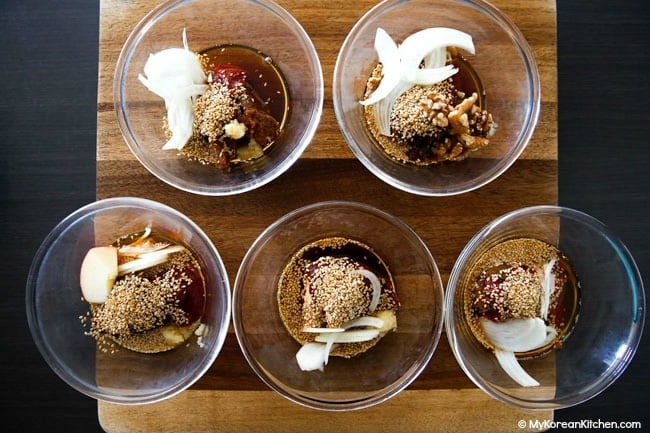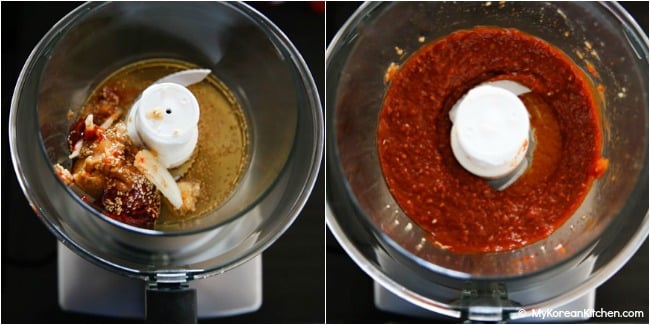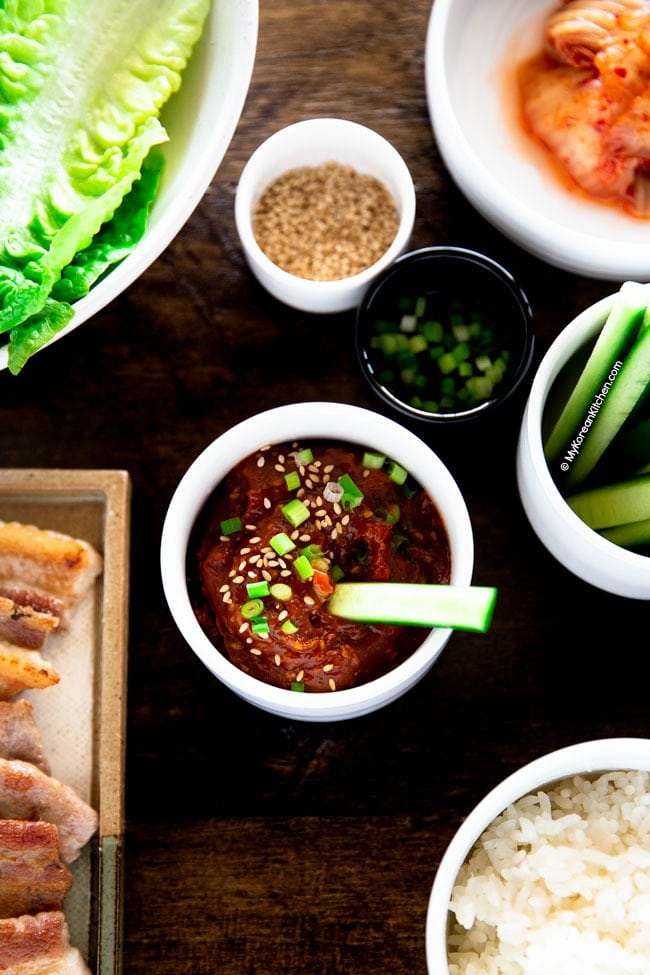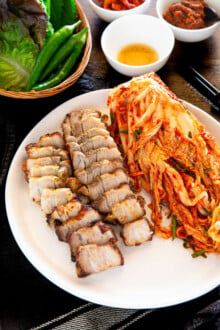Easy homemade ssamjang recipe!
Today I want to share one of the most popular Korean sauce – Sssamjang recipe.
Ssamjang (쌈장) is best known as a Korean bbq dipping sauce. It has mildly spicy and salty flavor with nutty fragrant. And, most importantly it compliments well Korean pork belly bbq (Samgyeopsal).
What is Ssamjang
It is a thick spicy paste made with Korean soybean paste (doenjang), Korean chili paste (gochujang) and other seasoning ingredients (garlic, onion, honey/sugar, sesame oil etc).
As I mentioned earlier before, it is most well known as a Korean barbecue condiment. Though, you can use it as a vegetable dipping sauce (e.g. cucumber and green chilies) and a wrap sauce as well.
While you can buy a container of pre-mixed ssamjang sauce from a Korean grocer, in my opinion, it can’t beat the taste of homemade ssamjang sauce. Nevertheless, if you want to see what pre-mixed ssamjang looks like, check from here (ssamjang brands).
How to Use
If you’re using ssamjang as a Korean barbecue dipping sauce, refer below image as it sums up what you should expect.
First, lay down a lettuce leaf (or any other leaves that are suitable e.g. perilla leaves) on your palm, then pile up some rice, Korean barbecued meat, and a bit of dipping sauce. Some kimchi, radish pickles, sliced raw garlic and chilies are popular adds on as well.
Bottomline, all of these food should be a bite sized pieces otherwise you will become a very messy eater!
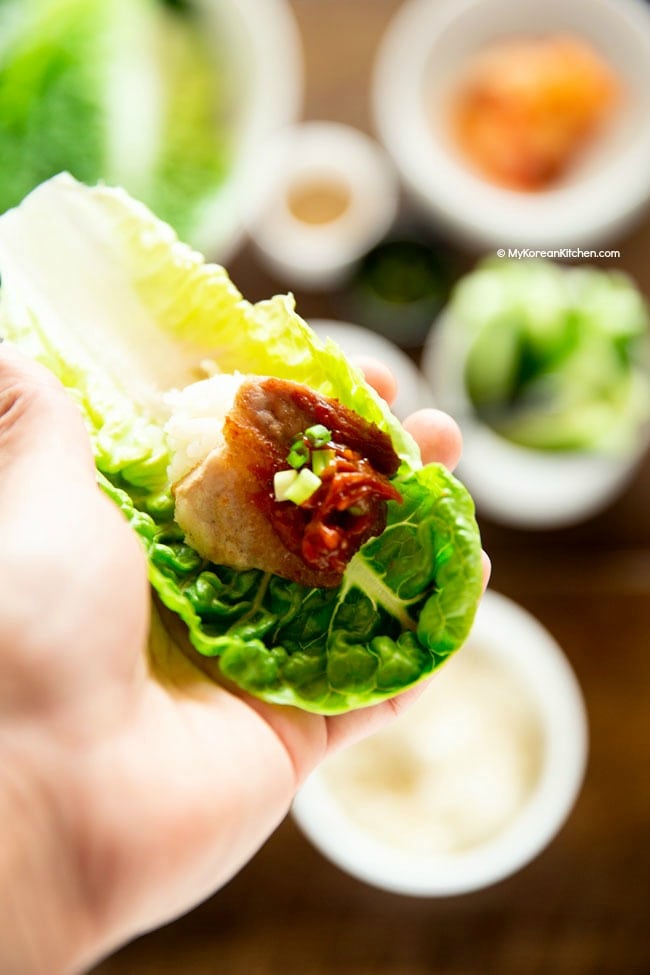
If you’re using ssamjang as a vegetable dipping sauce, just dip the vegetable stick into the sauce as you would with hummus.
Alternative Ingredients
If you know Korean food and Korean ingredients reasonably well, making ssamjang at home is no brainer. However, I know some of you don’t have the access to a decent Korean grocer or Asian grocer.
So I decided to share my fun experiments below by using non-Korean ingredients in my ssamjang recipe in a hope that it might help some of you.
As you can see from the above picture, I made my sauce in 5 different ways.
One of them uses Japanese miso (soybean paste) instead of Korean doenjang, and another version includes sriracha sauce instead of Korean gochujang.
Below lists show what went into each bowls and the difference is highlighted in bold.
- Doenjang (Korean soybean paste), Gochujang (Korean chili paste), Toasted sesame oil, Honey, Toasted sesame seeds, Minced garlic, Onion
- Doenjang (Korean soybean paste), Gochujang (Korean chili paste), Toasted sesame oil, Honey, Toasted sesame seeds, Minced garlic, Onion, Walnuts
- Doenjang (Korean soybean paste), Gochujang (Korean chili paste), Toasted sesame oil, Honey, Toasted sesame seeds, Minced garlic, Onion, Apple
- Miso (Japanese soybean paste), Gochujang (Korean chili paste), Toasted sesame oil, Honey, Toasted sesame seeds, Minced garlic, Onion
- Doenjang (Korean soybean paste), Sriracha sauce, Toasted sesame oil, Honey, Toasted sesame seeds, No garlic, Onion
All these versions result in slightly different taste and color, but they all pass as a good ssamjang sauce. 😉 One thing to note is that #5. ssamjang made with sriracha sauce was spicier than others.
Hope my little experiment gives you some inspiration!
Now on to the detailed recipe.
Ingredients for Ssamjang (Serves 6 to 8)
Main
- 1/4 cup doenjang (Korean soybean paste)
- 2 Tbsp gochujang (Korean chili paste)
- 2 Tbsp toasted sesame oil
- 1/2 Tbsp honey
- 2 tsp toasted sesame seeds
- 1/2 tsp minced garlic
- 10g / 0.35 ounces onion, thinly sliced
- (optional) 2 Tbsp walnuts (or your choice of nuts and seeds) – this will add nuttier flavor and creamier texture.
- (optional) 10g / 0.35 ounces apple, cored and cut into small pieces
Garnish
- (optional) green onion, thinly sliced
- (optional) minced chilies, finely diced
- (optional) toasted sesame seeds
* 1 Tbsp = 15 ml, 1 cup = 250ml
** If you want to learn more about Korean ingredients, check my essential Korean grocery ingredients!
*** When adding sesame oil and/or nuts, be sure to use the fresh ones. Old ones can be rancid and spoil the taste of ssamjang.
How to Make Ssamjang
Put all ingredients in a food processor and blend until the texture is smooth. It will takes about 1 min. Transfer the sauce into a serving bowl. Garnish with the green onion and sesame seeds.
How to Store
You can store unused portion of ssamjang in an air tight container and refrigerate until needed. From a food safety perspective consume within 3-5 days.
That being said, I have stored my sauce 1 – 2 weeks fine. This is not to say that you should do the same, just take the information for what it’s worth.
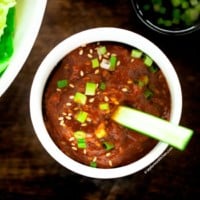
Ssamjang Recipe
Ingredients
Main
- 1/4 cup doenjang (Korean soybean paste)
- 2 Tbsp gochujang (Korean chili paste)
- 2 Tbsp toasted sesame oil
- 1/2 Tbsp honey
- 2 tsp toasted sesame seeds
- 1/2 tsp minced garlic
- 10 g onion , thinly sliced
- 2 Tbsp walnuts (or your choice of nuts and seeds) – this will add nuttier flavor and creamier texture.
- 10 g apple , cored and cut into small pieces
Garnish
- green onion (optional)
- green chilies (optional)
- toasted sesame seeds (optional)
Instructions
- Put all ingredients in a food processor and blend until the texture is smooth. It will takes about 1 min. Transfer the sauce into a serving bowl. Garnish with the green onion and sesame seeds.
Notes
Nutrition Info (per serving)
The nutrition information shown is an estimate provided by an online nutrition calculator. It should not be considered a substitute for a professional nutritionist’s advice.

